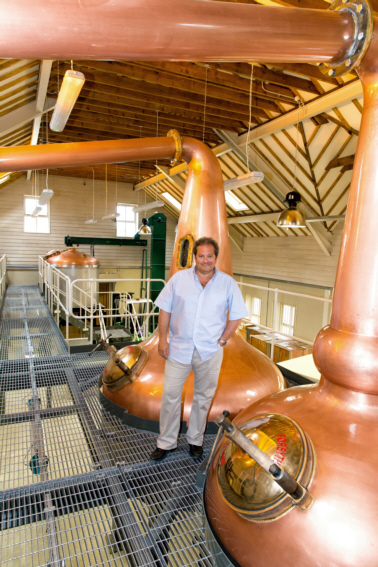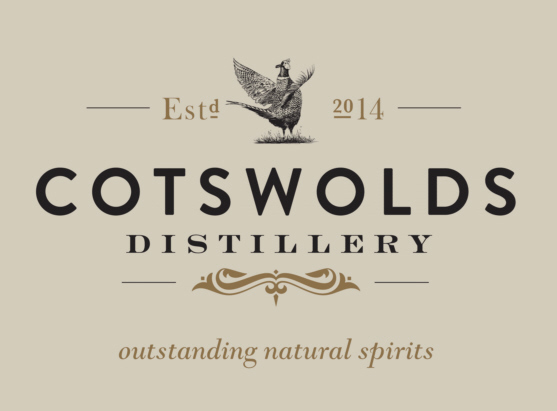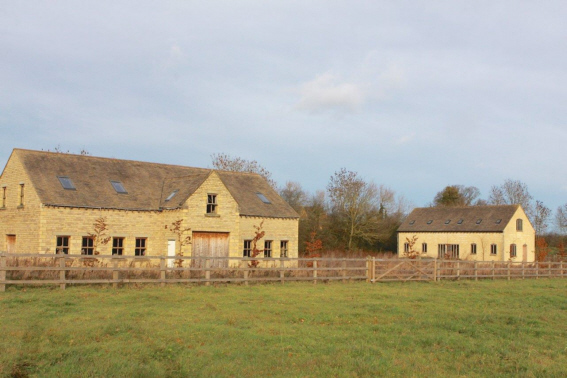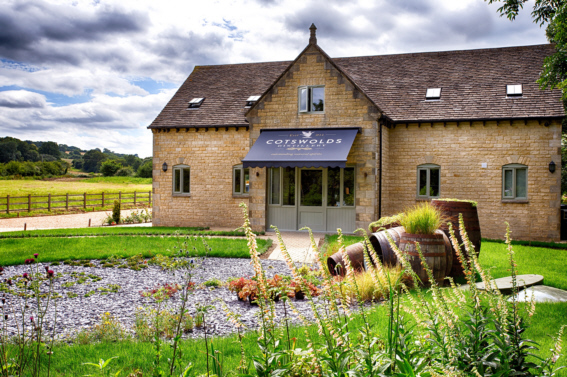Auch in England scheint der Whiskyboom angekommen zu sein, betrachtet man die steigende Zahl von Whiskybrennereien im Lande. Inklusive der sich noch in Planung oder Bau befindlichen Destillerien sollte England nun auch auf ein knappes Dutzend Brennereien kommen. In den Cotswolds, der Gegend, die auch als das Herz Englands bezeichnet wird, erfüllt sich Daniel Szor, ein Londoner aus der Finanzbranche, der sich vor ein paar Jahren in den Cotswolds niedergelassen hat, zur Zeit seinen Traum. Er baut sich ’seine‘ eigene Destillerie und kann bald ’seinen‘ eigenen Whisky brennen. In einem Interview mit dem Whisky-Journal beschreiben Daniel und der Head Distiller der Cotswolds Distillery, Alex Davies, die Hintergründe und Ziele des Projektes. Zunächst aber noch ein paar allgemeine Informationen über die neue Brennerei.
Die Cotswolds Distillery liegt in Nähe des kleinen Ortes Stourton knapp 60 km Luftlinie südlich von Birmingham und ist die erste Whiskybrennerei in den Cotswolds. Das Grundstück und die leerstehenden Gebäude, auf dem die Brennerei aktuell entsteht, gehören zum Phillip’s Field, einem ehemaligen landwirtschaftlichen Anwesen. Die Brennerei soll als sogenannte Craft Distillery nach amerikanischem Vorbild kleinere Mengen Alkohol in handwerklich sehr schottisch-traditioneller Weise produzieren. So kommt es nicht von ungefähr, dass man die Pot Stills von Forsyths in Rothes produzieren ließ. Auch beratende Starthilfe gab es durch Harry Cockburn und Jim Swan aus dem nördlichen Nachbarland.
Die regionale Verbundenheit ist jedoch ein wichtiger Baustein des Projektes. Daher werden alle Rohstoffe für den zukünftigen Cotswolds Single Malt aus den Cotswolds bezogen. Die ökologische Gerste für das erste Destillat stammt bespielsweise von der Bradwell Grove Farm im nahe gelegenen Burford. Die Gerste wird dann in Englands ältester Mälzerei in Warminster weiterverabeitet. Zum Maischen des in der Brennerei gemahlenen Malzes wird Quellwasser aus Oxfordshire verwendet.
Neben Single Malt Whisky sollen aber auch noch andere Spirituosen wie beispielsweise ein Rye Whisky, Gin oder Liköre das Geschäftsmodell tragen. Eine Investition von mehr als 4 Millionen Britischen Pfund muss schließlich auch irgendwie finanziert werden. Neben Eigenkapital und der Familie soll ein Sponsormodell helfen, wobei 50 Investoren jeweils 50.000 Britische Pfund hinterlegen – gerne mit persönlichem Engagement für Whisky, weniger mit der reinen Absicht möglichst viel Gewinn zu erzielen.
Der erste Single Malt soll schon im September diesen Jahres gebrannt werden – wohlgemerkt nur etwas mehr als ein halbes Jahr nachdem die Arbeiten an der neuen Destillerie begonnen haben. Ein wenig Glück gehört auch dazu, denn Forsyths konnte die Stills nur so schnell liefern, da ein anderer Kunde sie nicht mehr haben wollte und seinen Auftrag stornierte. Szor griff in Anbetracht der passenden Spezfikationen sofort zu. Der erste Malt soll dann voraussichtlich im Oktober 2017 auf den Markt kommen. 5000 Flaschen, die zur Zeit schon (vor-)verkauft werden, werden als Erstlingswerk abgefüllt. Ebenso kann man sich individuell Fässer abfüllen lassen, die dann für eine Zeit von wenigstens 5 Jahren vor Ort lagern werden.
Die Lagerung erfolgt aus Platzgründen allerdings nicht in den Cotswolds, sondern in den Kellers eines alten Lagerhauses in Liverpools historischen Merseyside Docks. Hier lagern bereits unzählige Rumfässer unter perfekten Temperaturen und in einem sehr speziellen Ambiente. Ein einmaliger Glückgriff, wie der Brennereibesitzer Daniel Szor meint. Doch würde man es auch gerne sehen, wenn in Zukunft wenigstens Teile der Produktion auf dem eigenen Grund reifen könnten.
Nun aber zum Interview mit Dan Szor und Alex Davies. Zum Zeitpunkt des Interviews waren die Antworten auf meine Fragen noch nicht auf der Website der Cotswolds Distillery oder im Word Wide Web zu finden. Ein paar Informationen wurden zwischenzeitlich nachgeliefert und ein paar andere in Interviews veröffentlicht, aber die Originalantworten will ich natürlich niemandem vorenthalten.
 An dieser Stelle ein herzliches Danke Schön an Dan und Alex für ihre ausführlichen Antworten, sowie an Rachel Tranter (Marketing & PR bei der Cotswolds Distillery) für die Bilder der Brennerei. Here we go…
An dieser Stelle ein herzliches Danke Schön an Dan und Alex für ihre ausführlichen Antworten, sowie an Rachel Tranter (Marketing & PR bei der Cotswolds Distillery) für die Bilder der Brennerei. Here we go…
WJ: Having been a whisky-lover for 20 years and getting the chance to build up something unique, do you need to be more brave or more crazy to grab the chance?
DAN: A bit of both, I suppose. Certainly it was brave in that I am not a super-wealthy guy doing this as a hobby, just someone who has been stuck for many years in a well-paying but passionless career who now would like to do something I can be passionate about and make something I can smell, feel and taste. Hopefully it is not crazy but rather a calculated bet – I feel that the concept has great validity but I am also aware of the financial challenges presented by a start-up distillery. I hope it all works out; I think, however, that had I not taken this opportunity that would have regretted it for the rest of my life. And you only live once…
WJ: What was your personal trigger to say ‚yes, let’s try it‘?
DAN: Several things happened at roughly the same time. Firstly, my wife and I bought a beautiful old farmhouse and barn in the middle of the Cotswolds countryside as a weekend home, and soon realized that this was really “the good life” and that we wanted to leave the city to live here full time. But what to do out here for a living? One day I looked out my window at the field behind my house that was planted in barley, and the thought came to me – “there’s a lot of barley in the Cotswolds but no one is distilling”. Secondly, I became aware of the growing craft distilling movement in the USA, and this made me feel that as a business model this sort of thing might be doable. Thirdly, I presented the idea to a role model of mine, Jim McEwan of Bruichladdich, and asked him whether he thought I was crazy or should go ahead with it. His response was “what are you waiting for?” and he put me in touch with our wonderful Scottish consultant Harry Cockburn (ex-manager of Bowmore) who has 50 years of distilling experience, is a pleasure to work with, and assured me he could help me to fulfil this dream and make excellent spirit in the Scottish tradition. Finally, we had 2 very lucky events last fall – we found a perfect property, full of character, close to home and with planning permission for this sort of activity, and then around the same time Forsyths told us that they could build us stills in 2014 rather than the 2-3 waiting list we were told to expect. Very fortuitous…
WJ: Your business model seems familiar when looking at other young distilleries. How do you want to differentiate on this emerging market, besides being the first distillery in the Cotswolds?
DAN: I don’t think we need to completely reinvent the wheel; there aren’t yet so many new distilleries that we feel the need to be completely different from them all; rather, I would like to pull elements from each one which I feel is “doing things right” and sidestep those elements which I feel we could do better. For example, I think St Georges (English Whisky Company) makes a very decent whisky in the Scottish tradition but that their marketing and image is weak, and that we are in a better part of the UK insofar as tourism and local uptake are concerned. Sipsmith, on the other hand, has a very average (in my opinion) product but excellent marketing. I hope to marry these two elements successfully.
WJ: Your presentation is really professional, both regarding PR and equipment. That must have cost some money. How much will you have spent until the first single malt is bottled and sold?
DAN: Thank you for your compliment on our presentation, I feel I was very lucky to have found Craig Mackinlay of Breeze Creative in Glasgow who has done quite a bit of whisky design, including all of the work for Kilchoman and several projects for Bowmore, Auchentoshan, etc. Without going into all of the financial details, I can say that we are in what seems to be the typical financial profile of this type of project, which is to say there is a cost of several million pounds to get the thing up and running. The PR was actually relatively easy as there is a real interest in this sort of story….
WJ: How much alcohol can one of the smallest distilleries in Great Britain produce p.a.?
ALEX: With regards to the whisky, we are aiming to produce 50,000 liters of pure alcohol this year, so just over a cask a day (at 63.5%)! We will, to begin with, be running one shift a day. This will allow us time to run each process in the distillery once a day. As for the gin, we will be crafting our spirit to meet demand and to keep a constant supply of stock. Running on a solitary batch a day, 5 days a week, we have the capacity to produce around 180,000 bottles a year. We can very easily double whisky production and triple gin production daily by introducing a split shift pattern allowing us to share a longer day between the team.
(Nachtrag der ‚Redaktion‘: Die Mashtun fasst 500 Kilogramm pro Füllung und man erwartet etwa 300 Liter Ertrag daraus, was ungefähr 1,5 Fässern entspricht. Man rechnet mit einer realistischen Produktionsmenge von 150.000 Flaschen pro Jahr)
WJ: What is actually the size of your stills? And why stills from Scotland and from Germany?
ALEX: We have two whisky stills from Forsyth’s in Scotland. Our wash still has a capacity of 2400l and our spirit still has a capacity of 1600l. Our Holstein still has a capacity of 500l and has been made in Germany. This is what we will be using to distill our gin and all manner of other spirits that we decide to put our hand to! We have plenty of plans in the pipeline!
WJ: On your website I can see a wash back made of steel. Any reason for not having chosen a wooden wash back when being so tradition-minded?
ALEX: There are several reasons for choosing to use stainless over wood for our washbacks. Using stainless will help us to maintain consistency in our product as it is a much more consistent material to work with and we will be better able to maintain them and keep them clean for a better fermentation. There is a lot of story surrounding the use of wood and its impact on the flavour of the wash and on the whisky, but in reality it has been shown that it really is all story nowadays. Distilleries do still use the wood more for the story and for consistency as they have been traditionally using wood for hundreds of years, so changing it now could impact the flavour as they will be changing the process. We are utilising so many traditional techniques and methods in our whisky production already, we also want to run as a modern distillery; crafting a spectacular and consistent whisky, reminiscent of the Scottish Single Malt style, so that is why did decided not to use wooden washbacks.
WJ: You state on your website that you are using both bourbon and sherry casks for maturation. Are you planning to mature your whisky the entire time in either of these cask types, maybe marrying casks in the end?
ALEX: This is absolutely right! We will be carefully ageing our whisky using both Bourbon casks and Sherry casks to begin with. As time goes on and our whisky matures we will then have options for bringing the two together in absolute harmony. We are already excited about working on a blend for our first whisky. It may contain more bourbon cask, it may contain more sherry, but it will definitely contain a healthy blend of the two. That is not to say that future editions (select bottlings/limited runs) will definitely not contain a single cask type though! We may also have another, secret, cask that we will have access to for our whisky.
WJ: Will you be using first fill casks only, also for the sherry casks?
ALEX: As we are aiming to craft a truly magnificent, super premium single malt whisky, we will be using first fill casks.
WJ: Is it a particular type of sherry that has been matured in your sherry casks before or are there various?
ALEX: That is a great question, this would of course make all kinds of difference in the final spirit. For now, I am unable to say what styles of sherry, but do stay in close contact and all will be revealed in due course.
WJ: What are your plans regarding maturation time after the first single malt is ready after three years and one day? You only state ‚probably much longer‘ on your homepage. How many years do you think will be best for a whisky from the Cotswolds?
ALEX: There is something quite magical about the changes that the spirit in a cask undergoes over time. This is a very organic process that we will never able to have complete control over. It would be great if we found that after 3 years, our whisky was perfect for the bottle, but truth be told? I cannot tell you for certain. The whisky will be ready, when it is ready. And that is all I can be certain of.
WJ: Your team of distillers seems to be rather young and quite creative. Can we thus expect innovative results in the bottles (btw, very nice design!) you sell?
DAN: You can expect both tradition and innovation from us; in terms of the former, my goal is to start by producing single malt whisky that is true to the Scottish technique and tradition as in my view that is the best in the world. Brands like Kavalan in Taiwan and Ichiro in Japan take the same approach, I believe – they start of by “going by the book” but of course every whisky is different and they inevitably end up putting their own unique imprint on the product. This is how I see things going here regarding whisky. We will hopefully start experimenting with Rye next year, perhaps aging it in new wood for an “American-style” spirit – which would be unique for England. Where I see the most innovation is in the products we make in our Holstein still, i.e. contemporary gins, brandies and perhaps even Absinthe – this still is perfect for small runs and I plan to give our distillers more free reign on this than the whisky, which I feel should be made in the traditional manner…
WJ: How did you convince the other members of the team to work for the same chance that you have seen?
DAN: When I began looking for distillers I first thought to hire a 20-year Scottish veteran – for the sake of credibility more than anything else – but then realised that even if I could lure such a person (they are typically well-paid, with many pension, etc benefits, and want to stay in Scotland) this would not necessarily be the right fit. I realised that we needed younger, passionate (but well-educated) members for our team – guys who really wanted to make their mark on the world, and saw this as their opportunity. I can honestly tell you that, having seen our three guys working hard at it over the past three weeks, I completely made the right decision. I could not be happier with the way the team is coming together.




